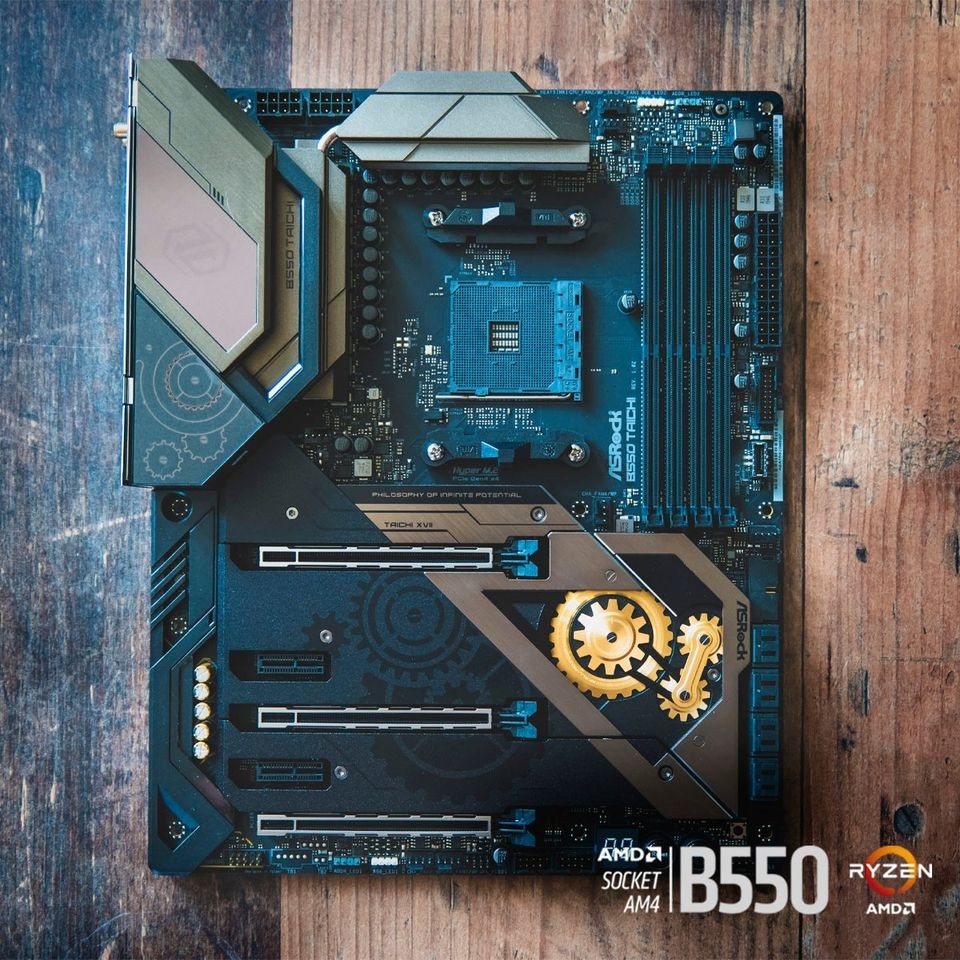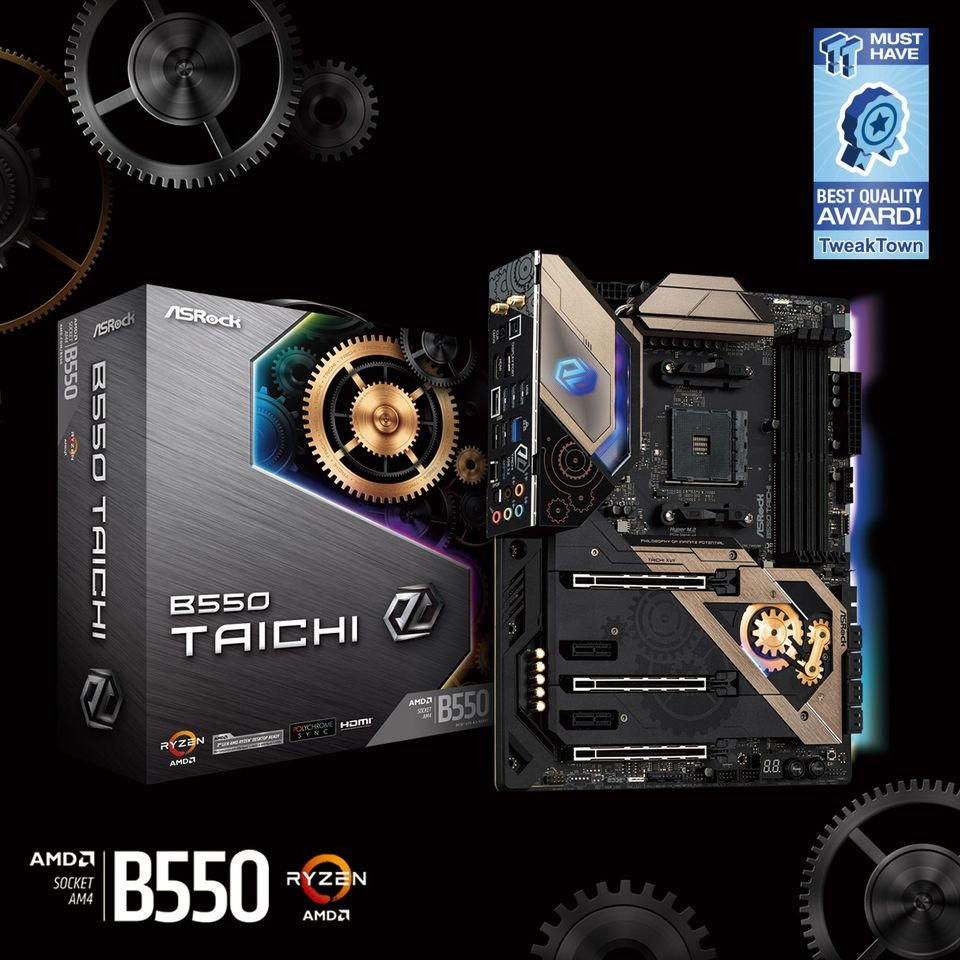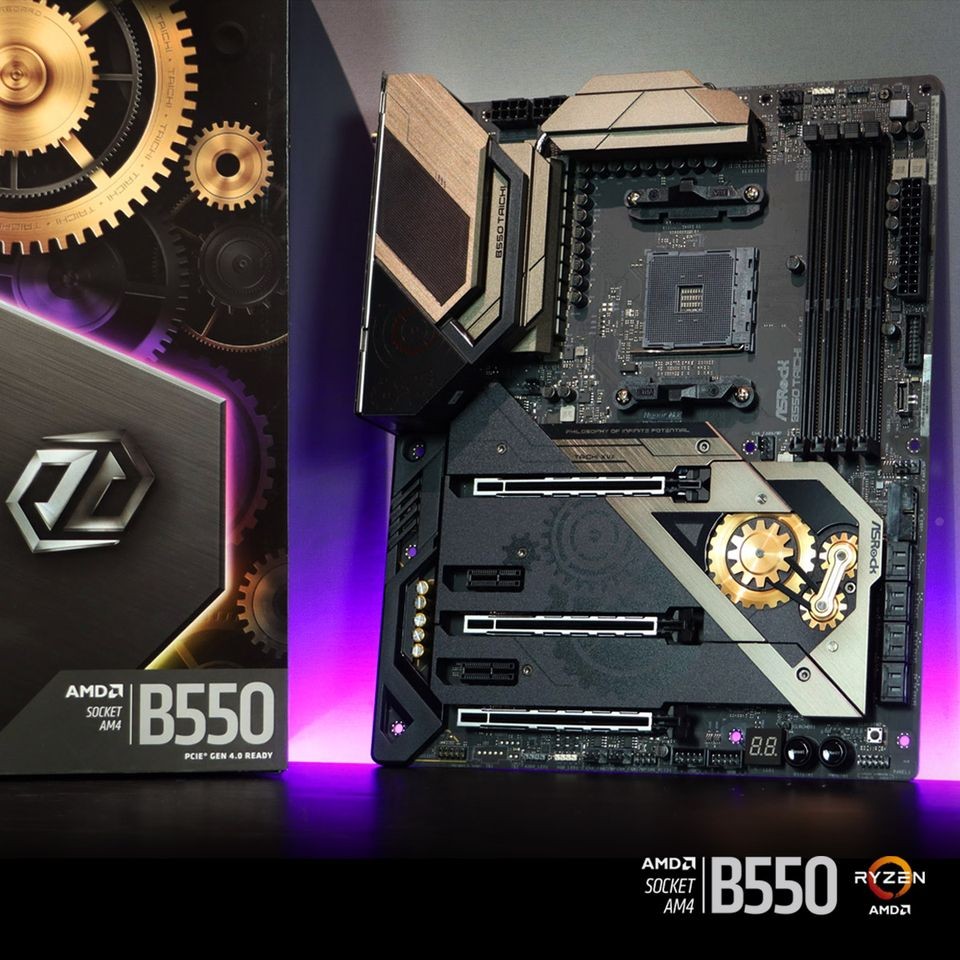
The way that AMD is controversial is the naming of the chipset along with the accompanying technology, the obvious difference of the B550 compared to the X570 is mainly in the support of PCI-E 4.0 lanes for the chipset. Assuming the user is using an X570 motherboard that comes with one of the AMD Ryzen 3000 Series processors, there will be 16 PCI-E 4.0 lanes divided by the graphics card, 4 lanes divided by the storage devices. and 4 lanes will be connected to the AMD X570 chipset. The total number of PCI-E 4.0 lanes available is 24, a number so that numerology believers can enjoy playing a lotto or poker.
But if we put the AMD Ryzen 3000 Series processor into the B550 motherboard, we will still have 16 PCI-E 4.0 lanes divided by the graphics card, 4 lanes divided for storage devices but 4 PCI lanes- The other E 4.0 will disappear and be replaced by the older PCI-E 3.0. If you plug in a storage device that eats up PCI-E 4.0 bandwidth through this PCI-E 3.0 lane, of course the performance will drop compared to the theoretical level, this becomes a "small" problem for you. with many people.
Obviously, the B550 chipset is also quite high-end because it carries a lot of features similar to the X570. But naming the chipset as B, which can be understood as Balance or Basic (simple) has made motherboards using this chipset become "cheaper", despite carrying a lot of features. premium, even better than the X570.
In today's article, we will go into detailed analysis of the differences between X570 Taichi and B550 Taichi ., to know which product is better than which or which one is better? About Taichi, needless to say, a product brand that ASRock has worked hard to build for more than 4 years and has created a huge buzz in the technology village. In terms of product segment, Taichi is now behind the Phantom Gaming X and Aqua series, but still carries with it innovative design and top quality.
First, to analyze the differences of motherboards, we need to dive into the main ideas, including:
- Design of the VRM circuit.
- Support for storage devices (SATA, NVMe, USB, etc.)
- Maximum memory capacity and clock support
- Sound and Networking
- Aesthetics and convenience
I. X570 Taichi vs B550 Taichi : Which board's VRM circuit is better?
The motherboard wants to work well with CPUs with high TDP, multiple cores, high pulses, of course, there must be a good VRM circuit. However, different VRM designs will lead to different effects. When comparing the VRM of the X570 Taichi compared to the B550 Taichi by analyzing the VRM circuit, the writer found that the B550 Taichi was slightly better than the X570 Taichi.

X570 Taichi according to the advertisement from ASRock is designed with a VRM circuit with 12 + 2 power phases. However, analyzing a bit more deeply about the VRM circuit, ASRock uses Digital PWM driver IC ISL69147 with 6D+1 configuration. In which the phases for CPU vCore and SOC are equipped with PowerStages Vishay SiC634 50A. Thanks to the doubler design with phase channel driver IC ISL6917A, the total DC current for the circuit is 600A vCore and 100A SOC.
Meanwhile, B550 Taichi is advertised by ASRock with a 14+2 VRM circuit design. Going into details, ASRock uses Digital Renesas RAA229004 controller IC with 7D+2 configuration, the phases for CPU vCore and SOC still use PowerStages Vishay SiC634 50A, bringing the total DC current to the circuit to 700A CPU vCore and 100A SOC. Both motherboards are equipped with Premium 60A chokes and premium Nichicon 12K capacitors.

The common feature to emphasize in both the X570 Taichi and B550 Taichi motherboards is that the company favors the design of the best VRM and PCH cooling solution. In which the aluminum alloy assembly for the VRM is designed with many air intakes and the connection between the heatsink cluster is a heatpipe. This ensures that the heat during operation is dissipated in the best way, even when running with a high TDP CPU or when overclocking, ensuring long-term system stability. However, there are some small changes although the heatsink cluster for the VRM is quite similar. But because the X570 Taichi uses the X570 chipset, the PCH part is equipped with a genuine fan, providing 4.92 CFM of airflow and is rated to have a lifespan of 50,000 hours thanks to the EBR bearing design.
In general, the B550 Taichi in the VRM circuit is better than the X570 Taichi. But in practice it would be difficult to tell the difference between the two motherboards without dedicated thermal measuring devices.
Winner: B550 Taichi
II. X570 Taichi vs B550 Taichi: The ability to support the clock and the maximum capacity of memory between two motherboards?

As said at the beginning of the article, the difference between the B550 and X570 is mainly in the PCIe Gen4 lane. Therefore, the ability to support the maximum memory capacity of the two motherboards X570 Taichi and B550 Taichi are similar, up to 128GB DDR4. But the B550 Taichi once again took the lead, supporting clocks of up to 5,000 MHz (OC) for the Matisse processor family and up to 5,200 MHz (OC) for the 4th Gen Ryzen APUs. Meanwhile, X570 Taichi can support up to 4,666 MHz (OC) for Ryzen Matisse processors, 3,600 MHz (OC) for Ryzen Pinnacle Ridge and 3,466 MHz (OC) for Ryzen Picasso series. Both motherboards support XMP Profile and the RAM slots are 15μ gold plated against noise and oxidation.
Winner: B550 Taichi
III. X570 Taichi vs B550 Taichi: The ability to support graphics?
Because X570 Taichi uses the X570 chipset, the PCIe x16 slots all support PCIe 4.0, while the B550 Taichi has two PCIe x16 slots that support PCIe 4.0 and one slot is PCIe 3.0. However, one feature to note, if using the fifth PCIe slot on the B550 Taichi, the bandwidth will be reduced from x4 to x2 if the second or fourth PCIe slot is used.
In addition, the biggest advantage of the X570 Taichi is that it supports 2 Way SLI, while the B550 Taichi does not. . This means that users can use Nvidia's NVLink or Quad SLI with the X570 Taichi and the B550 Taichi "Say No".

Winner: X570 Taichi
IV. X570 Taichi vs B550 Taichi: Ability to support storage devices?
X570 Taichi and B550 Taichi are both designed to support up to 8 SATA 3 ports. But X570 Taichi supports up to 3 M.2 slots, while B550 Taichi has only 2 M.2 slots. These M.2 slots are all equipped with aluminum heatsinks for best heat dissipation when operating.

The X570's three M.2 slots all support PCIe 4.0 and two slots 1 and 3 support SATA 3. Meanwhile with the Taichi B550, only one M.2 slot supports PCIe 4.0, while the other is PCIe. 3.0 and can support SATA III. It should be noted that if the X570 Taichi's third M.2 slot is used, the fifth PCIe slot will be disabled.
Winner: X570 Taichi.
V. X570 Taichi vs B550 Taichi: Audio support, RGB LED and network connectivity?
The sound area of both the X570 Taichi and B550 Taichi are the same, equipped with Nichicon's 5 high-end condensers, providing warm, natural sound with clearer tones. Noise filtering circuitry is also equipped to clearly separate analog / digital signals to reduce interference from many sides. The latest Realtek ALC1220 audio processing chip, an electronic circuit that amplifies the OP-AMP Texas Instruments TI NE5532 signal, supports headphones with impedances up to 600 Ohms. At the same time, the 3.5mm jacks are also 15μ gold-plated to prevent interference and oxidation, providing the best sound quality.
Using a set of computers with many LED lighting effects is a trend among users, which has become more attractive than ever. To keep up with the trend and stay ahead, ASRock has also equipped their motherboards with the latest LED features. This new generation of LED allows users to easily create their own unique personal lighting effects. Both motherboards are equipped with onboard RGB LEDs and additionally integrated ARGB and RGB headers.

On the networking side, both Taichi motherboards are Wi-Fi 802.11ax compatible, using the Intel Wi-Fi 6 AX200 wireless network module for maximum speeds of up to 2.4 GB/s. However, the LAN port on the B550 Taichi is better than that of the X570 Taichi when using an Intel I225-V controller clocked at 2.5 GB/s, while the X570 has an Intel I211-AT 1 GB/s controller.
In terms of connectivity, the B550 Taichi has an additional DisplayPort connector for the APU, in addition to the HDMI port that both motherboards have. The B550 has two USB 2.0 ports – in addition to two USB 3.2 Gen2 ports (Type-A and Type-C) and four USB 3.2 Gen1 ports – while the X570 converts those two USB 2.0 ports into two USB 3.2 Gen1 ports, for a total of six. USB 3.2 Gen1 port and two USB 3.2 Gen2 ports. The B550 has one more USB 3.0 connector (2 total) and an additional 4-pin fan pump header (7 in total) when compared to the X570 (1 USB 3.0 header, 6 4-pin fan headers).
Winner: B550 Taichi.
Summary
With the result of "all-out" after this analysis, it is hard to say which motherboard is better than another without going into the specifics of each person's use. If you like overclocking, want to optimize performance when running with processors with many cores and high TDP, along with redundant network connections, choose the B550 Taichi. On the other hand, if you want to maximize the performance of using graphics and storage devices, such as plugging in 2 VGA RTX 2080Ti to run NVLink, or plugging in 3 M.2 PCIe 4.0 devices, choose X570 Taichi .
ASRock X570 Taichi and ASRock B550 Taichi currently have almost the same price. So, to choose a suitable motherboard, it depends on your needs and preferences. If you feel that the B550 is a bit "cheap", choose X570 Taichi or want something new, choose the opposite.
And what is certain is that both of these motherboards offer excellent value when used with the latest AMD Ryzen AM4 processors.

